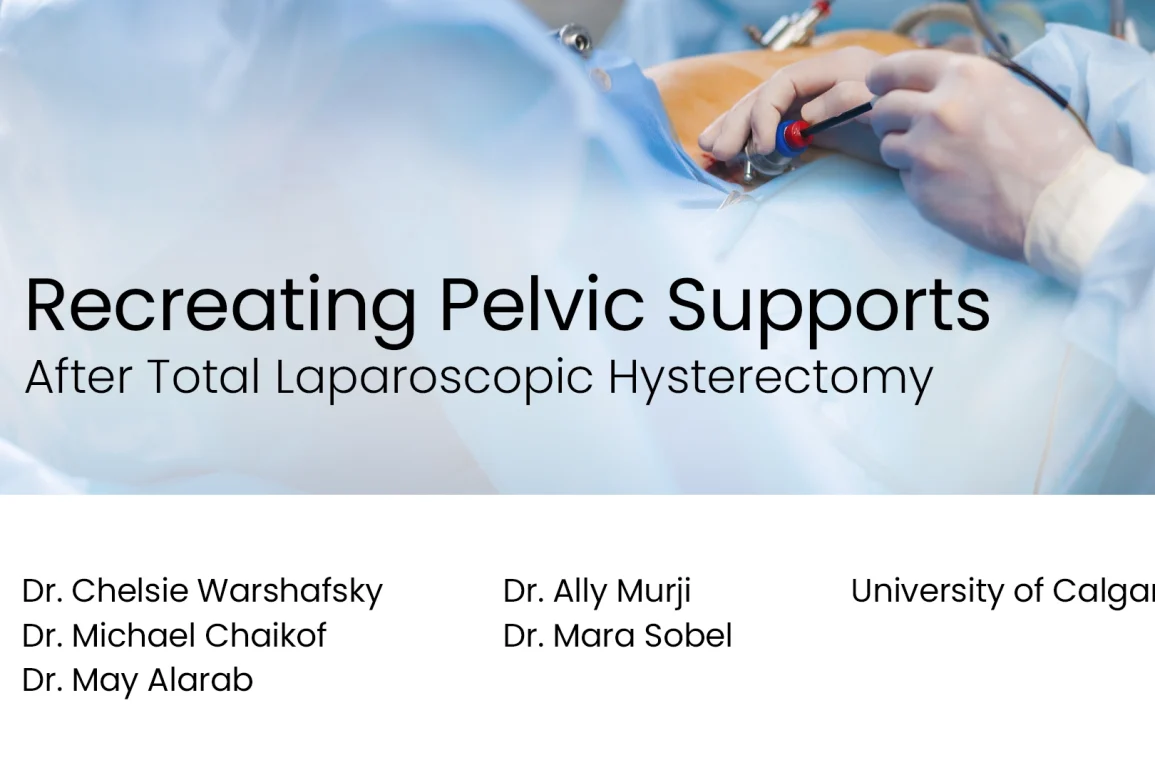Table of Contents
- Procedure Summary
- Authors
- Youtube Video
- What is Recreating Pelvic Supports After Total Laparoscopic Hysterectomy?
- What are the Risks of Recreating Pelvic Supports After Total Laparoscopic Hysterectomy?
- Video Transcript
Video Description
This video reviews techniques to recreate pelvic supports and mitigate long term surgical complications of laparoscopic hysterectomy including: (1) ophoropexy and (2) vault suspension.
Presented By
Affiliations
University of Calgary
Watch on YouTube
Click here to watch this video on YouTube.
What is Recreating Pelvic Supports After Total Laparoscopic Hysterectomy?
What are the Risks of Recreating Pelvic Supports After Total Laparoscopic Hysterectomy?
The risks of recreating pelvic supports after total laparoscopic hysterectomy (TLH) stem from the complexity of the procedure and the potential for complications. Key risks include:
-
Pelvic Organ Prolapse: Even with pelvic support reconstruction, there remains a risk of pelvic organ prolapse, especially if the supports weaken over time.
-
Infection: The introduction of sutures or mesh to reinforce the pelvic floor can increase the risk of infection, which may require further treatment or surgery.
-
Nerve or Tissue Damage: During the process of recreating pelvic supports, there is a risk of inadvertently damaging surrounding nerves, blood vessels, or tissues, leading to pain, numbness, or other complications.
-
Mesh Complications: If mesh is used for support, there is a risk of mesh erosion, pain, or infection. In some cases, the mesh may need to be removed surgically.
-
Chronic Pain: Some patients may experience long-term pelvic pain as a result of the procedure or due to scar tissue formation.
These risks should be discussed with a healthcare provider to ensure informed decision-making and appropriate post-surgical care.
Video Transcript: Recreating Pelvic Supports After Total Laparoscopic Hysterectomy
Recreating pelvic supports after total laparoscopic hysterectomy. The objective of this video is to review techniques to recreate pelvic supports and mitigate long-term surgical complications of laparoscopic hysterectomy.
One of the lesser recognised complications of laparoscopic hysterectomy includes ovarian pathology. When the ovaries are left in situ, they have less attachments, and thus ovarian torsion can occur. Ovaries can also become adherent to the vaginal vault, especially if the indication for surgery was endometriosis.
Vaginal vault prolapse is another known complication of hysterectomy. The risk of development depends on the same factors that are considered for any pelvic organ prolapse. We present a simple technique to mitigate the risk of these complications. First, we attach the ovaries to the round ligaments. Then we secure the vaginal vault to the uterosacral ligaments.
Part one, oophoropexy. In this video, we suture the ovary to the round ligament to keep it secure and held in place. A figure-of-eight suture is placed to bring the structures together. This can be tied intracorporeally or extracorporeally, depending on surgeon preference.
If the surgeon prefers not to suture, the same technique can be achieved using an endoloop. The endoloop is inserted into the pelvis. The round ligament and ovary are each grasped through the loop and brought together. The endoloop is then tightened around them. As you can see, both ovaries are now secured in place and far away from the vaginal vault.
The next step is to secure the vaginal vault to the uterosacral ligaments using a modified McCaul’s culdoplasty. The uterosacral ligaments are identified below the vaginal vault.
The course of the ureter is assessed to ensure it is lateral to where the suture will be placed. A stitch is placed through the uterosacral ligament and left loose at its end. The suture is then run superficially along the vaginal vault from one end to the other, ensuring not to go lateral to the vaginal angle.
The other uterosacral is then grasped. And again, the course of the ureter is assessed. The suture is then placed through the other uterosacral ligament. Once this is pulled through, the free end of the suture is grasped. The ends are brought together, and the suture is tied intracorporeally.
Care should be taken to hold the knot in place as it is tied, given the amount of tension on the suture. Ensure enough knots are placed depending on the suture material you choose. You can see the uterosacrals are pulled together with the vaginal vault, ensuring additional support.
In summary, we have presented two surgical techniques to consider following a laparoscopic hysterectomy. By connecting the ovaries to the round ligaments and the vaginal vault to the uterosacral ligaments, we can recreate pelvic supports and mitigate long-term surgical complications.




